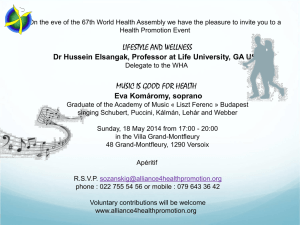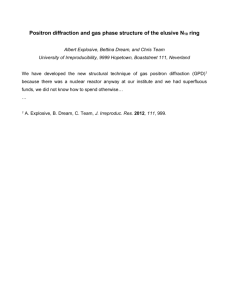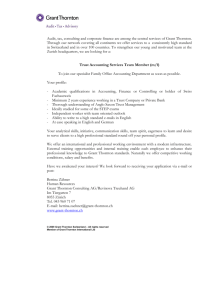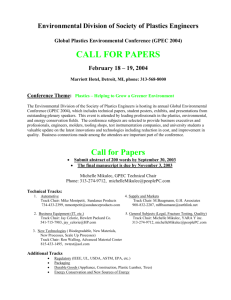Photon Counting with a 512 x 512 Pixel Array at 1 kHz Frame Rate
advertisement
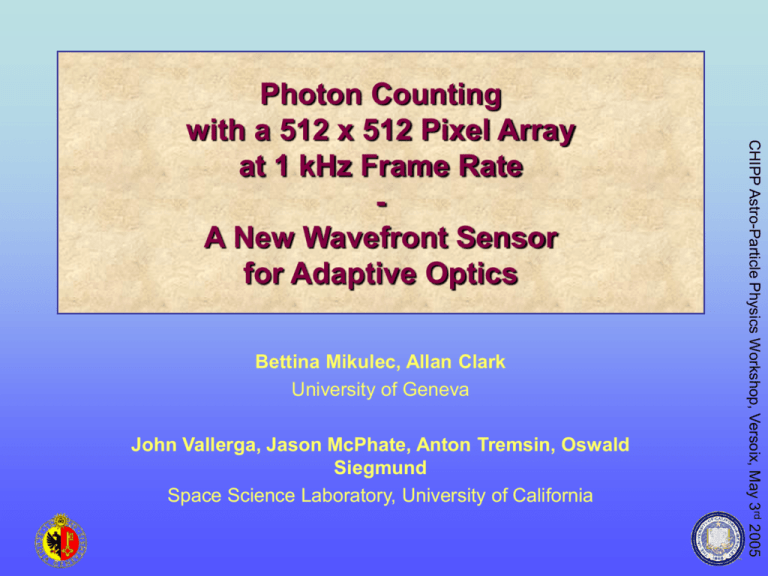
Bettina Mikulec, Allan Clark University of Geneva John Vallerga, Jason McPhate, Anton Tremsin, Oswald Siegmund Space Science Laboratory, University of California CHIPP Astro-Particle Physics Workshop, Versoix, May 3rd 2005 Photon Counting with a 512 x 512 Pixel Array at 1 kHz Frame Rate A New Wavefront Sensor for Adaptive Optics Introduction into Adaptive Optics* – Temperature fluctuations in the air cause changes in the index of refraction – light rays are no longer parallel when they reach telescope and can therefore not anymore be focused to a point Point focus Parallel light rays blur Light rays affected by turbulence Even the largest ground-based astronomical telescopes have no better resolution than an 8" telescope! Bettina Mikulec *adapted from AO lectures of Claire Max, Astro289C, UC Santa Cruz 2 CHIPP Astro-Particle Physics Workshop, Versoix, May 3rd 2005 • Turbulence in the earth’s atmosphere makes stars twinkle • More importantly, turbulence spreads out the star light making it a blob rather than a point Adaptive Optics Bettina Mikulec 3 CHIPP Astro-Particle Physics Workshop, Versoix, May 3rd 2005 proposal for a new WFS Optical Medipix tube Adaptive Optics Bettina Mikulec 4 CHIPP Astro-Particle Physics Workshop, Versoix, May 3rd 2005 Example for the enormous improvements using AO (Lick Observatory). The new generation: adaptive optics on 8-10 m telescopes Subaru 2 Kecks ESO VLT Gemini South Gemini North And at other places: MMT, VLT, LBT, Gemini South Bettina Mikulec 5 CHIPP Astro-Particle Physics Workshop, Versoix, May 3rd 2005 Summit of Mauna Kea volcano in Hawaii: Next Generation of Large Telescopes (proposed) TMT All propose AO systems with > 5000 actuators Bettina Mikulec 6 CHIPP Astro-Particle Physics Workshop, Versoix, May 3rd 2005 30 m diameter: – California Extremely Large Telescope (CELT) – Thirty Meter Telescope (TMT) 50 m diameter: – EURO50 on La Palma 100 m diameter: Palomar – European Southern Observatory’s “OverWhelmingly Large Telescope” Hale 5m (OWL) telescope Adaptive Optics Shack-Hartmann wavefront sensor Bettina Mikulec 7 CHIPP Astro-Particle Physics Workshop, Versoix, May 3rd 2005 • Determine the distortions with the help of a natural or laser guide star and a lenslet array (one of the methods). Deviations of the spot positions from a perfect grid is a measure for the shape of the incoming wave-front. Wavefront Sensor Requirements • • Large pixel array, high frame rate and no readout noise not simultaneously achievable with CCDs! Bettina Mikulec 8 CHIPP Astro-Particle Physics Workshop, Versoix, May 3rd 2005 High QE for dimmer guide stars (~80% optical QE) Gate the detector in 2-4 s range for operation with laser guide stars o Many pixels in the order of 512 x 512; future large telescopes will have about 5000 actuators (controlled via 70 x 70 centroid measurements) • 1000 photons per spot to get a 3% centroid rms error with respect to the stellar image size. o 1 kHz frame rate (light integration, readout, calculations, send out 5000 signals and ready for new frame); faster than the timescale of the atmospheric turbulences o Very low readout noise (< 3e-) Proposal for a New Wavefront Sensor Photocathode Photon e- Q = 104e- Pij = Pij + 1 Window MCP Medipix2 2 µm pores on 3 µm centers (Burle Industries) Bettina Mikulec 9 CHIPP Astro-Particle Physics Workshop, Versoix, May 3rd 2005 High-QE GaAs photo-cathode Matched pair of microchannel plates (MCP) with 10 m pore diameter in chevron configuration Medipix2 counting CMOS pixel chip Integrate photon events on pixel, noiseless chip readout The Medipix2 Photon Counting Chip Bettina Mikulec 10 CHIPP Astro-Particle Physics Workshop, Versoix, May 3rd 2005 m CMOS technology (33M transistors/chip) square pixel size of 55 µm 256 x 256 pixels sensitive to positive or negative input charge (free choice of different detector materials) pixel-by-pixel detector leakage current compensation window in energy discriminators designed to be linear over a large range 14-bit counter per pixel count rate: ~1 MHz/pixel (0.33 GHz/mm2) 3-side buttable serial or parallel I/O (min. readout time of full matrix 266 µs) 0.25 Measurement Setup • A Medipix2 photon counting chip • A matched pair of MCPs: Photonis MCPs with 33 mm diameter 10 m hole diameters, L/D = 40/1 low resistivity (~22 MOhms per plate) gain was varied between 20k and 200k (1430 - 1680 V) • Vacuum tank pumped down to ~10-6 torr • Hermetic feed-throughs (50-pin connector for Medipix signals) • A standard UV Hg pen-ray lamp with collimator (~10 counts/s -500M counts/s) Bettina Mikulec 11 CHIPP Astro-Particle Physics Workshop, Versoix, May 3rd 2005 – – – – Feasibility Tests 06 April 2004 gain 106, rear field 427 V gain 50k, rear field 980 V It works! • Event size function of MCP gain, rear field, MCP-Medipix distance and Medipix threshold Bettina Mikulec 12 CHIPP Astro-Particle Physics Workshop, Versoix, May 3rd 2005 single photon events Flood Fields • Take image with collimated UV source at 50ke gain and 1600 V rear field (~5000 counts/pixel). Average single spot area: 2.4 pixels Ratio = flood1 / flood2. Histogram of ratio consistent with counting statistics (rms 0.02) – Fixed pattern noise from dead spots on the MCPs and MCP multifibres divides out. Bettina Mikulec CHIPP Astro-Particle Physics Workshop, Versoix, May 3rd 2005 take 2 independent uniform illuminations (flood fields at ~500Mcps) 13 Resolution • The Air Force test pattern was used to demonstrate the imaging properties of the detector, in particular the resolution. 100 s exposure; the spots correspond to individual photon events. Bettina Mikulec 1 s exposure. Group 3-2 visible (~9 lp/mm corresponding to the Nyquist limit of 55 m pixels) 14 CHIPP Astro-Particle Physics Workshop, Versoix, May 3rd 2005 increase shutter time Event Centroiding • Centroiding individual photon events to achieve sub-pixel resolution: centroiding Group 4-2 starts to be resolved (17.95 lp/mm; 55.7 m corresponding to ~28 m pixels). Could be useful for low rate imaging applications! Bettina Mikulec 15 CHIPP Astro-Particle Physics Workshop, Versoix, May 3rd 2005 – Take many very low count rate images with larger spot area to avoid overlapping spots. (~100-150 counts/frame; 1000 frames) – Identify unique spots and reject overlapping events (counts 2), count spots, record their size and calculate the centroids. UV Photon Counting Movie Air Force resolution mask, 100 ms exposures Bettina Mikulec 16 CHIPP Astro-Particle Physics Workshop, Versoix, May 3rd 2005 QuickTime™ and a YUV420 codec decompressor are needed to see this picture. Spot Size vs. Gain Pinhole grid mask (pitch 0.5 mm x 0.5 mm) to simulate ShackHartmann spots: Gain: 200 000 Bettina Mikulec Gain: 20 000 17 CHIPP Astro-Particle Physics Workshop, Versoix, May 3rd 2005 Rear field: 1600V, gap 500 m, threshold 3 ke- Sub-Pixel Spatial Linearity Pinhole Detector Bettina Mikulec 18 CHIPP Astro-Particle Physics Workshop, Versoix, May 3rd 2005 Lamp Average Movement of ~700 Spots 0 Centroid Position (µm) Delta Y -20 -30 1 pixel -40 -50 -60 -70 -80 -90 -100 0 5 10 15 20 25 Lamp Position (mm) • Achieved a 2 m rms centroid position error with ~550 events/spot. Bettina Mikulec 19 CHIPP Astro-Particle Physics Workshop, Versoix, May 3rd 2005 Delta X -10 Electron Detection • First test results with beta sources 63Ni, 67 keV max. ~300 counts/pixel 204Tl, 764 keV max. ~100 counts/pixel QE ~46% for Ni and ~63% for the Tl image; increasing efficiency with e- energies above ~50 keV consistent with literature. Bettina Mikulec 20 CHIPP Astro-Particle Physics Workshop, Versoix, May 3rd 2005 Gain ~60k, rear field 1600 V Medipix threshold ~38 ke- Conclusions Bettina Mikulec 21 CHIPP Astro-Particle Physics Workshop, Versoix, May 3rd 2005 • New detector concept proven to work! • Performed systematic tests varying different detector parameters • No fixed pattern noise yet detectable except MCP imperfections • Resolution at Nyquist limit and below (for event-by-event centroiding) demonstrated • Images presented with both UV and electron sources detector has a great capacity to be used for various wavelengths and particles Ongoing work – reduce output bandwidth by using an FPGA; goal: 1 kHz continuous frame rate with 2x2 chip arrangement • Test prototype tubes at the AO laboratory at CFAO, U.C. Santa Cruz • Final test at a telescope SSL received 3-year NOAO grant, 1.5 more years to go…, some funding for Univ. Geneva from Fonds National and F. Schmidheiny • Consider other applications for such a detector Bettina Mikulec 22 CHIPP Astro-Particle Physics Workshop, Versoix, May 3rd 2005 • Test new ceramic chip carrier (= tube backend); thermal cycling tests with Medipix2 chip mounted • Tube fabrication at SSL Berkeley and at commercial firm with GaAs photo-cathode • Test prototype parallel readout board designed in collaboration with ESRF Parallel Readout Board CHIPP Astro-Particle Physics Workshop, Versoix, May 3rd 2005 23 Bettina Mikulec Tube Design CHIPP Astro-Particle Physics Workshop, Versoix, May 3rd 2005 24 Bettina Mikulec Tube Design CHIPP Astro-Particle Physics Workshop, Versoix, May 3rd 2005 25 Bettina Mikulec Bettina Mikulec 26 CHIPP Astro-Particle Physics Workshop, Versoix, May 3rd 2005 Backup Slides! The Setup at SSL - Photos CHIPP Astro-Particle Physics Workshop, Versoix, May 3rd 2005 27 Bettina Mikulec Spot Size Rear Field = 1600V Spot Area vs Rear Field 20 35 Gain 50k Gain 100k 30 Spot Area (pixel) 18 Mean Spot Area (pixel) Gain 25k Gain 200k 25 Gain 400k 20 15 10 5 16 G=20k, Area 14 G=50k, Area 12 G=100k, Area 10 G=200k, Area 8 6 4 2 0 0 200 400 600 800 1000 1200 Rear Field (V) Spot area versus rear field. Bettina Mikulec 1400 1600 0 0 5 10 15 20 25 30 35 40 Lower Threshold (ke -) Spot area versus Medipix2 low threshold. 28 CHIPP Astro-Particle Physics Workshop, Versoix, May 3rd 2005 40 100 Cs Br KI 80 60 40 20 0 0.1 Bettina Mikulec Energy (keV) 1 29 CHIPP Astro-Particle Physics Workshop, Versoix, May 3rd 2005 Quantum Detection Efficiency (%) Soft X-Ray Photocathodes EUV and FUV CsI 1985 vs 1999 0.7 0.6 0.5 QDE 0.4 0.3 0.2 0.1 0 0 500 1000 1500 2000 Wavelength (Å) Bettina Mikulec 30 CHIPP Astro-Particle Physics Workshop, Versoix, May 3rd 2005 CsI 1985 30° CsI 1985 20° CsI #3 2/99 20° CsI #3 2/99 30° CsI #2 1/99 20° CsI #2 1/99 30° GaN UV Photocathodes, 1000- 4000Å CHIPP Astro-Particle Physics Workshop, Versoix, May 3rd 2005 31 Bettina Mikulec Isoplanatic Angle (0) & Sky Coverage Telescope Primary mirror Bettina Mikulec 32 CHIPP Astro-Particle Physics Workshop, Versoix, May 3rd 2005 h Laser Guide Stars Bettina Mikulec 33 CHIPP Astro-Particle Physics Workshop, Versoix, May 3rd 2005 Can achieve >70% sky coverage with laser guide star adaptive optics! Laser Guide Star Parallax 589.2 nm L d Bettina Mikulec 34 CHIPP Astro-Particle Physics Workshop, Versoix, May 3rd 2005 • “Star” more of a streak • Shape changes over pupil • Can use pulsed laser to limit spatial extent • Requires gated detector Advantages of Multi-Pixel Sampling of Shack Hartmann Spots 5x5 algorithm error for Gaussian input Quad cell (2x2) algorithm error for Gaussian input 0.5 = = = = = Sigma Sigma Sigma Sigma Sigma 0.2 0.4 0.6 0.8 1.0 Calculated position Calculated position Sigma Sigma Sigma Sigma Sigma 0 0.2 0.4 0.6 0.8 1.0 0 -0.5 -1 -0.5 = = = = = 0 Gaussian Centroid true position 2x2 0.5 -1 -0.5 0 Gaussian Centroid true position (center pixel) 5x5 Linear response off-null Insensitive to input width More sensitive to readout noise Bettina Mikulec 35 CHIPP Astro-Particle Physics Workshop, Versoix, May 3rd 2005 1 Deformable Mirrors • Range from 13 to > 900 actuators (degrees of freedom) CHIPP Astro-Particle Physics Workshop, Versoix, May 3rd 2005 ~ 300mm ~ 50 mm Bettina Mikulec Xinetics 36 Position Error (550 Events/Spot) Number of centroids 45 40 35 30 rms = 2.0 µm 25 20 15 10 5 0 -20 -15 -10 -5 0 5 10 15 20 Centroid difference (microns) Bettina Mikulec 37 CHIPP Astro-Particle Physics Workshop, Versoix, May 3rd 2005 50 Medipix readout of semiconductor arrays CHIPP Astro-Particle Physics Workshop, Versoix, May 3rd 2005 38 Bettina Mikulec X-ray of Fish (… with silicon detector) Bettina Mikulec 39 CHIPP Astro-Particle Physics Workshop, Versoix, May 3rd 2005 QuickTime™ and a Cinepak decompressor are needed to see this picture.
